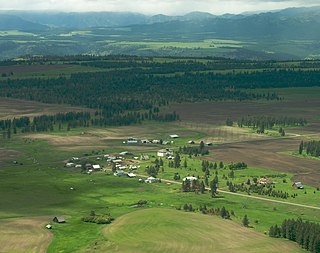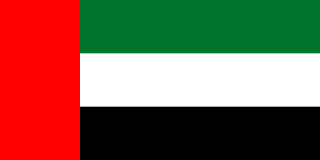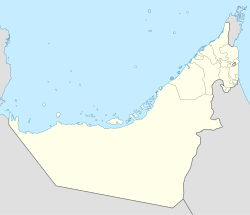
The United Arab Emirates (UAE) is a country in the eastern part of the Arabian Peninsula located on the southeastern coast of the Persian Gulf and the northwestern coast of the Gulf of Oman. The UAE consists of seven emirates and was founded on 2 December 1971 as a federation. Six of the seven emirates combined on that date. The seventh, Ras al Khaimah, joined the federation on 10 February 1972. The seven sheikdoms were formerly known as the Trucial States, in reference to the treaty relations established with the British in the 19th Century.

Khatt is a mountainous village south-east of the city of Ras Al Khaimah, United Arab Emirates. Famous for its hot springs, and latterly home to a spa hotel, there is evidence that Khatt has been a site of constant human settlement since the stone age – a record of over 5,000 years of occupation.
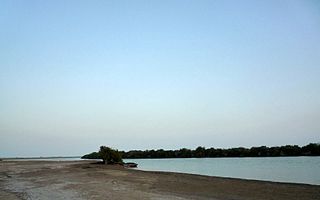
Kalba is a city in the Emirate of Sharjah in the United Arab Emirates (UAE). It is an exclave of the emirate of Sharjah lying on the Gulf of Oman coast north of Oman. Khor Kalba, an important nature reserve and mangrove swamp, is located south of the town by the Omani border. The town was captured by the Portuguese Empire in the 16th century and was referred to as Ghallah.
The Bani Kaab is an Arab tribe in Oman and the United Arab Emirates, also evident in other Gulf countries.

The Arabian tahr is a species of tahr native to eastern Arabia. Until recently, it was placed in the genus Hemitragus, but genetic evidence supports its removal to a separate monotypic genus.

Wadi Zikt consists of the confluence of the lower reaches of the Wadi Wurayah and a number of other watercourses. The Wadi Zikt dam, also known as the Al Rahib dam, is one of the largest in Fujairah. It is one of many dams built in the country for storing fresh water. The dam was completed in 1992 or shortly after.

Al Hayl is a suburb of Fujairah, United Arab Emirates (UAE), at the mouth of the Wadi Hayl. It is traditionally the home of the Kunud tribe.

Qidfa is a settlement and oasis in Fujairah, United Arab Emirates (UAE). It is the site of the Fujairah power and desalination plant, the largest in the UAE.
The Naqbiyin ) is a tribe of the United Arab Emirates (UAE). They are mostly settled within the emirates of Sharjah and Ras Al Khaimah and have long been influential in the tribal politics of both emirates.

Wadi Wurayah is a 12,700 hectares area between the towns of Masafi, Khor Fakkan and Bidiyah in the United Arab Emirates. It has been designated as Ramsar Wetland of International Importance.

Al-Hajar Mountains in northeastern Oman and also the eastern United Arab Emirates are the highest mountain range in the eastern Arabian peninsula. Also known as "Oman Mountains", they separate the low coastal plain of Oman from the high desert plateau, and lie 50–100 km (31–62 mi) inland from the Gulf of Oman.

Al Bithnah is a village in Fujairah, United Arab Emirates (UAE), long occupying a strategic location in the Wadi Ham, which is the only natural link to the interior of the UAE and the Persian Gulf from the East Coast city, and Emirate, of Fujairah.

The Wadi Suq culture defines human settlement in the United Arab Emirates and Oman in the period from 2,000 to 1,300 BCE. It takes its name from a wadi, or waterway, East of Sohar in Oman and follows on from the Umm al-Nar culture. Although archaeologists have traditionally tended to view the differences in human settlements and burials between the Umm Al Nar and Wadi Suq periods as the result of major external disruption, contemporary opinion has moved towards a gradual change in human society which is centred around more sophisticated approaches to animal husbandry, particularly the domestication of the camel, as well as changes in the surrounding trade and social environments.
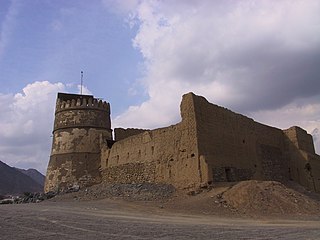
Wadi Ham is a wadi in Fujairah, United Arab Emirates.
Sheikh Hamad bin Abdullah Al Sharqi is the first recognised leader of the Al Sharqi Ruling family of Fujairah, one of the Trucial States and today one of the United Arab Emirates (UAE). He led Fujairah in a number of insurrections against Al Qasimi rule, presiding over a turbulent time when the emirate was practically independent but denied recognition of status as a Trucial State in its own right by the British.
Sheikh Mohammed bin Hamad Al Sharqi was the Ruler of Fujairah, one of the Trucial States which today form the United Arab Emirates (UAE), from 1938–1975. In 1952 he was to see his father's long-held dream of independence for Fujairah recognised, as well as shortly afterwards to help take the UAE to independence as a nation, in 1971.
The Sharqiyin is a tribe of the United Arab Emirates (UAE).
The area currently known as the United Arab Emirates (UAE) was formerly populated by inhabitants of a number of coastal and inland settlements, with human remains pointing to a pattern of transmigration and settlement as far back as 125,000 years. Prehistoric settlement in the UAE spanned the Neolithic, with a number of distinctive eras of ancient settlement including the Stone Age Arabian Bifacial and Ubaid cultures from 5,000 to 3,100 BCE; the Hafit period with its distinctive beehive shaped tombs and Jemdet Nasr pottery, from 3,200 to 2,600 BCE; the Umm Al-Nar period from 2,600 to 2,000 BCE; the Wadi Suq Culture from 2,000–1,300 BCE and the three Iron Ages of the UAE.
The territory currently known as the United Arab Emirates was home to three distinct Iron Age periods. Iron Age I spanned 1,200–1,000 BCE, Iron Age II from 1,000–600 BCE, and Iron Age III from 600–300 BCE. This period of human development in the region was followed by the Mleiha or Late Pre-Islamic era, from 300 BCE onwards through to the Islamic era which commenced with the culmination of the 7th century Ridda Wars.
